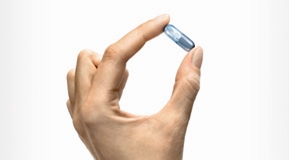

Oxygen is a vital gas that is of great significance in medical care throughout the world, from routine use and home medical care to more urgent treatment.
According to studies, survival in patients with hypoxia (e.g. COPD or sleep apnea) can be prolonged by several years if the patient receives regular oxygen therapy. This is particularly the case because the treatment makes an active lifestyle possible.
AGA AB, Linde Healthcare in Sweden, was the first in Europe to register the medicinal product oxygen in accordance with the new updated rules. We ensure every step in the process with regard to production, delivery and provision of oxygen. If necessary, we can trace gases, vessels and valves. The whole system, including delivery, rent and oxygen, is covered by the pharmaceutical benefits scheme.
Oxygen in the home
There are three different systems for oxygen therapy in the home. The doctor will recommend a suitable system.
Systems with liquid oxygen
Oxygen in cylinders
Oxygen concentrators
Dosage and equipment
Always dispense oxygen according to the doctor's instructions. Never experiment on your own initiative.
Use only pressure regulators and flow meters intended for oxygen therapy.
The regulator on the gas cylinders means that the high pressure in the cylinder is reduced. This means that the oxygen that is breathed is not under high pressure.
When using a humidifier glass, make sure that it is clean and in the upright position.
Safe use
Always read the instructions before using or transporting the equipment.
Do not touch the frosty parts of your HomeLox equipment. Liquid oxygen is extremely cold (-183°C) and on contact with bare skin can cause frostbite on the skin.
Never try to repair the equipment yourself.
Equipment not in use must be switched off.
Maintenance is important. Fat and oil can become self-igniting when they come into contact with oxygen under high pressure. Therefore keep valves and couplings free from such substances and make sure that no fat enters the valves when you connect the pressure regulator to the equipment. On the other hand, it is safe to use skin creams or lipsalve during oxygen therapy.
Travelling with oxygen
Contact your doctor to do an altitude test if you are unsure about your need for medical oxygen during flights.
Most airlines will not allow you to take equipment for medical oxygen on board. You should therefore contact the airline before travelling.
Fire risk
Oxygen is not flammable in itself, but increased oxygen content in the air can accelerate the fire process and lead to substances that are otherwise fire-resistant being ignited.
Never place an oxygen mask or nasal cannula directly on or in textiles (clothing, bedwear) when the equipment is in use. Oxygen flowing out can "saturate" textiles and make them very easy to ignite and flammable.
If you suspect that textiles are "oxygen-saturated", it is important that they are shaken and aired properly. It is not sufficient just to air them briefly.
Smoking and naked flames (such as candles, stoves and fireplaces) are prohibited near oxygen equipment.
Never use electrical equipment such as hairdryers or toasters while oxygen therapy is in progress.
In the event of a fire, switch off the equipment.
Oxygen in Medical Care
Supply of oxygen is a very basic action in modern medical care. Oxygen enrichment of the inhaled air is a fundamental symptomatic measure in all patients showing signs or symptoms of oxygen deficiency. Oxygen therapy in the home may be relevant for patients with chronic obstructive pulmonary disease (COPD), severe asthma and sleep apnea syndrome.
Medical oxygen is available at healthcare centres, in ambulances, in emergency departments and in wards. The oxygen is taken either from smaller oxygen cylinders or through pipes from the hospital's central gas system.
Oxygen can be supplied either through a nasal catheter or a breathing mask. In ventilation therapy in intensive care and under anaesthetic, medical oxygen is used to give the inhaled air the oxygen concentration that corresponds to the patient's needs.
Medical oxygen is the standard treatment for carbon monoxide poisoning, either as oxygen therapy at normal air pressure and high flow or in severe cases with positive pressure (hyperbaric pressure therapy).

